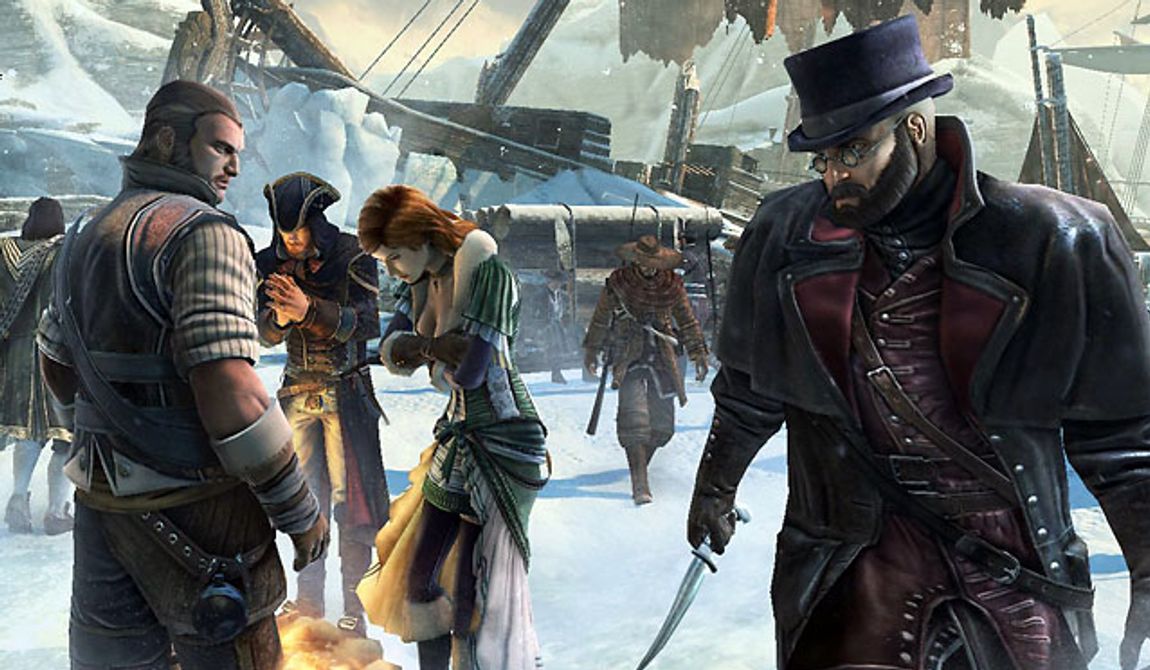Desmond Miles’ stealthy ancestors are on hand to witness the birth of a nation while killing plenty of redcoats in the third-person adventure game Assassin’s Creed III (Ubisoft, reviewed for Xbox 360, rated M for mature, $59.99).
Players fascinated by the events surrounding the American Revolution and appreciative of expansive, open-world exploration; historical detail; and bloody combat are in for an unforgettable experience.
As Miles, our familiar protagonist, tries ultimately to save the modern world from a global catastrophe, he must once again plug into the Animus device. This time, he relives the memories of his forefathers, now caught up in the impending Colonial conflict with Britain and the centuries-old Assassin vs. Templar war.
The player is taken on a whirlwind tour of the burgeoning fight for America’s freedom — covering roughly the years from 1753 to 1783 — and touching on famed events such as the battles at Lexington and Concord, the midnight ride of Paul Revere, the Boston Massacre, the Battle of Bunker Hill and a certain Tea Party.
The story may play out with too much hand-holding, but it grabbed my attention with a sucker punch after I spent many an hour controlling the nobleman Haytham Kenway. Just as I got used to this strong and manipulative assassin, my fears were realized.
I won’t divulge his ultimate agenda, but the game shifts to the perspective of his young son, Connor (a.k.a. Ratonhnhaké:ton), who was born from a liaison with a tough American Indian woman. The continued narrative takes on “The Last of the Mohicans” meets “The Patriot” intensity as the war heats up.
Now in control of Connor, first as a boy and teen in training and then as a confident assassin, the player goes on an epic journey of revenge, trying to save the lands of his native people siding with the Colonists.
Our idealistic hero wields hidden dual wrist blades and a tomahawk for the simplest covert kills, and he eventually accesses many flintlock pistols and muskets (the time required to load a ball and powder are so painfully realistic), trip mines and smoke bombs.
His abilities fully complement his covert missions, which can be as simple as whistling while hiding in a well to lure enemies to their demise, carrying bodies to cover, eavesdropping on soldiers, and bribing town criers to lower his fame as a mysterious killer.
The game mechanics continue to give assassins the ability to scale and run around rooftops like InFamous’ Cole MacGrath and acrobatically move about like the Prince of Persia. He also still can climb to the highest points, survey the land to synchronize maps and masterfully dive into any nearby hay cart and pile of pine cones or leaves.
Besides progressing through the main story line, Connor’s life often is made busy as he tracks down pages of a famous almanac, collects feathers, contracts with assassins to kill for him in all of the Colonies, and cracks the complicated compilation Encyclopedia of the Common Man.
My appreciation of the Assassin’s Creed franchise always has included how it exposes players to history and its pivotal characters, even reading about them, as well as key locations and events, through the encyclopedic Animus database.
The feature generously returns, as I quickly was introduced to George Washington (first as a British soldier during the French and Indian War, no less), Samuel Adams, John Hancock, Thomas Jefferson, Benjamin Franklin, Gen. Edward Braddock and Paul Revere as well as the Stamp Act, the Battle of Fort Necessity and the Sons of Liberty.
By the way, take the time to listen to Franklin’s thoughts on being naughty with older women during a conversation he had with Haytham (culled from a letter he actually wrote in 1745). This guy was a real pistol.
Gorgeously detailed locations expand from Boston to Philadelphia with plenty of reason to roam and hunt in forested areas (explored mainly for killing and skinning animals for cash and barter).
Connor eventually has rights from his mentor and master assassin, Achilles Davenport, to invite craftsmen escaping the war onto his homestead. This sets up an extended economy-management system for the game and the ability to upgrade tools and weapons.
Spending time among brilliant war and political strategists, slaughtering bad guys, listening to opera, feeding a pig and playing a round of the board game Fanorona simply are not enough for developers, so they felt compelled also to toss in a surprisingly entertaining naval-warfare simulation as Cmdr. Connor moves up and down the East Coast in the Aquila, blasting away at enemy vessels.
He can steer the ship, open full sail, guide the ship into a dock, and instruct his crew to fire the cannons and swivel guns at hostile vessels. It is a well-done and welcome extra attraction to the main events.
Despite its all-consuming story, constant action and reverence to the historical period, there are design glitches. At one point, I had to restart a mission when one of my adversaries got stuck on top of a barrel while throwing rocks at me, no matter how hard I tried to kill him with a sword.
Along with the lengthy solo saga, the Assassin’s Creed package also offers the enjoyable return of eight-player online battles in which assassins kill assassins. Players hunt each other in arenas filled with civilians and use such auditory hints as heartbeats and whispers to track targets and avoid pursuers.
Options feature the new co-op Wolfpack mode and the choice of more than a dozen avatars, including a Pawnee warrior, a Hessian soldier, a Colonist sharpshooter, a Jack the Ripper wannabe and a seductress.
After I recently returned from touring the real Boston, Assassin’s Creed III delivered for me a virtual travelogue worth of additional memories while tapping into its tantalizing revision of history.
The action gives a player in pursuit of gaming happiness an ambitious effort lasting dozens and dozens of hours, making it one of the stars of 2012.
More important, the game may actually make gamers want to learn something about an incredible and dangerous time in American history.
• Joseph Szadkowski can be reached at jszadkowski@washingtontimes.com.













Please read our comment policy before commenting.